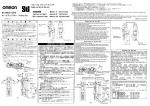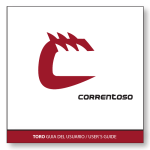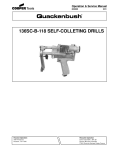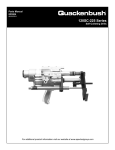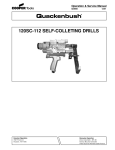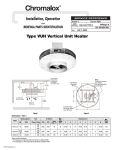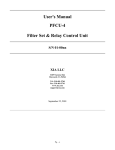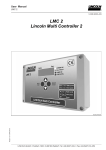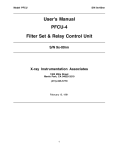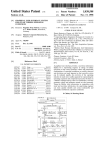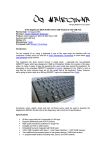Download User`s Manual PF4 Filter Set & PF2S2 Filter
Transcript
Models PF4 & PF2S2
S/N 9x-00nn
User's Manual
PF4 Filter Set
&
PF2S2 Filter-Shutter Set
S/N 9x-00nn
XIA
X-ray Instrumentation Associates
1300 Mills Street
Menlo Park, CA 94025-3210
(415)-325-5779
September 21, 1990
X
R
A
Y
INSTRUMENTATION
ASSOCIATES
1
Models PF4 & PF2S2
S/N 9x-00nn
Contents:
I: Warranty and Registration Card ........................................................... 3
A: Our guarantee policy ..................................................................... 3
B: Our repair service.......................................................................... 3
C: Warranty Card .............................................................................. 3
II: General Product Description............................................................... 4
A: Description 4
B: Technical Specifications ............................................................... 4
C: Applications................................................................................. 5
III: Installation 6
A: Mechanical Installation ................................................................. 6
B: Electrical Connections.................................................................. 6
C: Pneumatic Connection ................................................................. 7
D: Installing Filters or Shutters........................................................... 7
IV Operation
A: Normal Filter Set Operation ......................................................... 11
B: Selecting Filter Parameters.......................................................... 11
C: Multiple Foil Carrier Sets ............................................................. 12
D: Shutter Operation....................................................................... 12
V Maintenance and Service ................................................................. 13
A: Maintenance .............................................................................. 13
B: Service
............................................................................... 13
VI: Construction and Parts List ............................................................ 14
A: Parts List
............................................................................... 14
B: Assembly Drawing...................................................................... 16
2
Models PF4 & PF2S2
S/N 9x-00nn
Section I: Warranty and Registration Card
I.A. Our Guarantee Policy
Both PF4 filter sets and PF2S2 filter-shutter sets are guaranteed against failure under
normal operating conditions for 1 year from time of purchase. Should one of these products
fail, it will be repaired or replaced in as expeditious a manner as possible to minimize disruption
to its owner's experiments. In such an event please call us immediately to arrange for free
repair service. Be sure to register your instrument.
I.B. Our Repair Service
In line with XIA's goal of making your experimental life easier, we also have a repair
service which will attempt to repair, at a reasonable cost, any XIA instrument that fails, whether it
is in warranty or not. The components of this service, which can be selected as your needs
require, include:
1: Timely repairs: Our goal is to complete normal repairs in 2 working days or less.
2: Complete testing and checkout before return to assure that the repaired instrument will
continue to perform reliably.
3: Loaners: to keep your experiment running if we expect a delay in obtaining necessary
replacement parts.
4: Expedited handling: by 2nd day, overnight or even same day rush delivery to get you
going again in critical situations.
I.C. Warranty Card
In order to register your instrument for our guarantee policy, please fill out and return the
warranty card at the bottom of the Warranty Information sheet.
3
Models PF4 & PF2S2
S/N 9x-00nn
Section II: General Product Description
I.A. Description
The Model PF4 is an instrument for reproducibly attenuating an x-ray beam under
remote control by the insertion of four filter foils. It is physically compatible with Blake Industries'
line of beampath components and can be operated either evacuated or He filled if desired.
The foils are moved by miniature pneumatic cylinders which are controlled by electrically
actuated valves. O-rings provide vacuum seals on the cylinder shafts as they pass through the
instrument wall. As a result of careful design the entire instrument is very compact.
In the Model PF2S2, two of the filters are replaced by thicker absorber blades to create
a focal plane shutter. This design allows for a much more uniform spatial exposure than is
possible with single bladed shutters which open and then close. Further, by adjusting the time
between the opening of one blade and the closing of the other, it is possible to obtain
exposures which are shorter than the motion time of either blade. Attainable exposure times
vary with the mass of the blades and pneumatic supply pressure, but times less than 0.1 sec
are not difficult to produce. Either instrument can be retrofitted as the other.
I.B. Technical Specifications
Physical Size
100 mm in line, 62 mm wide, 200 mm high
Through beam size
20 mm H by 20 mm W for PF4
8 mm H by 20 mm W for PF2S2
Foil size
1" (25 mm) square; up to 3 mm thick
Pneumatic connection
Accepts 6 mm or 1/4" diameter polyethylene,
polyurethane or similar
Pneumatic medium
Compressed air or non-reactive gas, 5 mm filtered,
unlubricated
Required pressure
50 to 100 psi (3.5 to 7.0 bar)
Electrical Connection
Subminiature 9 pin D Plug [male] (AMP 745203),
accepts connections via 9 pin D Receptacle [female]
(AMP: 745201, ITT: DE111813, DuPont: 66168009, Cinch: 008-04108-9 {ref TE-9STS}, or other
equivalent)
Electrical Supply
24 V DC (+10%, -15%), 0.55 W per activated
valve.
I.C. Applications
1: The Model PF4 was originally designed to match single photon counting detectors to
synchrotron radiation experiments where the detected x-ray intensity varied over several
orders of magnitude. The experiment is optimized for acceptable counting rates with the
4
Models PF4 & PF2S2
S/N 9x-00nn
weakest signals and then the attenuators are inserted to maintain detector linearity in the
presence of strong signals. Examples include surface reflection studies, Huang scattering near
diffraction peaks, samples with both normal and "forbidden" peaks, etc. With a proper choice
of foil thicknesses and computer actuation of the PF4 valves, these experiments can be
completely automated.
2: With either manual or computer controls the PF4 also offers a convenient way to
match sample scattering strength to the detector's linear range even for samples whose
scattering intensity does not vary widely. This creates a very simple way to "tune" the
spectrometer to the sample in a standardized and reliable manner.
3: With a properly graded series of filters the PF4 also provides a simple way to adjust
x-ray "exposure" in those experiments requiring a particular x-ray dose (e.g. topographic
photographs). This capability is further enhanced in the Model PF2S2, which allows x-ray
exposures to be timed as well.
4: For radiation sensitive samples, using the PF4 with a heavy absorber replacing one
of foils is a convenient way to implement a beam stopper to minimize sample damage by
restricting exposure to only those times when data is actually being collected.
5
Models PF4 & PF2S2
S/N 9x-00nn
Section III. Installation
Installation consists of the following four steps: mechanically installing the body of the
instrument, making electrical connections, making pneumatic connection, and installing filters (or
shutters) in the filter carrier assemblies. These topics are treated in further detail below. Except
for explicit differences relating to shutter blade installation, which are treated in Sect. III.D, all
references to the PF4 apply to the PF2S2 as well.
III.A. Mechanical Installation
The PF4 is designed to be supported by an optical rail and make vacuum tight
connections with its neighboring beampath components. To this end it has an O-ring socket on
one end and an O-ring plug on the other. Both are sized to be compatible with the Blake
Industries' line of beampath components. Their dimensions are shown on the drawing in
Section VI.C if it is desirable to mate them to locally produced parts.
The PF4 can either be attached to it supporting optical rail or left simply supported
against gravity and held in line by its neighboring components as may be desirable.
Attachments can be made either by clamping or bolting it in place. Because potential mounting
arrangements vary so widely, no bolt holes have been provided. The body of the PF4 is
aluminum and such holes are easily added, although the obvious precautions against drilling into
the vacuum path should be taken.
III.B. Electrical Connections
Each valve requires 24 V DC (+10%, -15%) at 0.5 W (approximately 20 mA) to
operate. These control signals may be supplied by manual switches, CAMAC modules, or
electronically using any of a variety of driver devices. Quad driver packages with this capability
are now readily available commercially. A point to remember in choosing or designing control
circuitry is that the valves are inductors and the control electronics should be protected (by
bypass diodes) against the voltage surges which will arise when the valves are switched off.
Wiring to the PF4's 9 pin D connector is shown below. Each valve has an LED indicator
to show when it is energized, so it is important to observe the indicated polarity. The valves
are numbered sequentially, with Valve 1 closest to the D connector. This is also shown in the
assembly drawing, Sect. VI.C.
9 Pin D Connector
1
2
6
3
7
4
8
5
9
Pinning Chart
Valve
1
2
3
4
V+
6
7
8
9
V-
1
2
4
5
III.C. Pneumatic Connection
Connecting the pneumatic gas supply to the PF4 is very easily done via the supplied
push-pull Qwik-connect fitting. This fitting accepts either 6.0 mm or 1/4" high pressure plastic
6
Models PF4 & PF2S2
S/N 9x-00nn
gas line tubing. Polyethylene, polyurethane or similar tubing materials are acceptable. Simply
insert the gas supply line into the fitting until it bottoms and then pull up the red Qwik-connect
sleeve to lock the gas line in place. A point to remember in this procedure is that there is an
O-ring seal in the bottom of the Qwik-connect that will produce resistance as you insert the gas
line. Be sure the gas line is inserted completely through the O-ring to the bottom of the fitting.
If the connection fails to seal properly and leaks, this is the most likely cause. Also notice that
the Qwik-connect fitting rotates about its connection to the valve block and may be positioned
at any convenient angle.
The pressurized gas supply can be air or any non-reactive gas. It must be nonlubricated and, for longest cylinder life, be filtered through a 5 µm filter. Bottled gas can be
used. Pressures between 50 and 100 psi (3.5 to 7.0 Pa) are appropriate. If the pressure is
too low the cylinders will not move reliably, particularly after a period of disuse. You should
check your pressure setting by installing the foils you will actually use and activating the valves
to and observing whether the carriers operate smoothly.
III.D. Installing Filters or Shutters
Due to the close distances between the foil carriers, the most convenient way to install
foils (or shutter blades) is to first remove all the carriers from their cylinder shafts, load the foils
into the carriers, and then reinstall the carriers on the shafts. This process is described in detail
below, referring to the following figure.
Foil Carrier Assembly Drawing
Shaft
Assembly Bar
Lock Nut
Clip Nut
Clip Washer
Foil Carrier
Foil Clamp
Screw (4)
III.D.1. Installing Filter Foils
1: Filter Foils:
Filter foils can be made of any convenient material. Foil thickness is primarily limited
by the requirement that neighboring foil carrier assemblies do not interfere. Very
thick "foils" will act as beam stoppers, of course, and this is one of the modes in
which the PF4 is useful. Because of their greater mass, thicker foils will actuate
7
Models PF4 & PF2S2
S/N 9x-00nn
somewhat more slowly. Also, longer screws will be required to accommodate foils
thicker than about 1 mm.
Foil size (nominal):
1" x 1" (25 mm x 25 mm)
Screws (supplied):
4-40 Fillister Head x 3/16"
2: Removing Foil Carriers From Shafts:
a: Remove the upper half of the instrument by removing the 4 socket head
screws that attach it to the lower half. These are M5 x 0.8 SS Socket Head
screws, 30 mm long, so a 4 mm hex key or driver is required. Position the head
so the carriers are facing up, as in the drawing above.
b: Starting with the uppermost carrier, draw it out to the fully extended position by
hand and slide the assembly bar over the shaft between the lock nut and the
upper half body, as shown. The assembly bar will now hold the foil carrier in an
extended position while you work on it.
c: Supporting the foil carrier with one hand, use a pair of fine needle nose pliers to
remove the clip washer from the clip nut to free the foil carrier. Remove the foil
carrier from the clip nut.
d: By hand, pull on the clip nut to release pressure on the assembly bar.
Remove the assembly bar and return the shaft to its retracted position.
e: Repeat this operation for each of the remaining three foil carriers to remove it
from its shaft.
3: Installing the Foils:
Remove the foil clamp from the carrier by loosening the 4 screws. Place the foil so
it completely covers the hole in the foil carrier. Replace the foil clamp and screws.
Be certain the foil is still completely covering the hole and tighten the screws.
4: Replacing the Foil Carriers:
Reverse the steps in Section 2 above, starting with the lowest foil carrier. That is,
pull out the shaft and catch it with the assembly bar. Slide the foil carrier onto its
guide rods and onto the clip nut. Replace the clip washer and remove the
assembly bar to allow the foil carrier to retract. Test that the carrier operates
smoothly. After all the carriers have been reinstalled, replace the upper half
assembly into the lower half assembly and reattach it with the 4 screws.
III.D.2. Installing Shutter Blades
1: Installation Procedure:
The general procedure for installing shutter blades is the same as for installing filter
foils with the following two exceptions:
a: No foil clamp is used. The shutter blade is attached directly to the foil carrier by
two 4-40 screws.
b: Two shutter blades are installed, one per foil carrier, in complementary
positions as described below.
2: Shutter Blade Design:
The shutter blades normally provided are made of 1/8" (3.2 mm) stainless steel,
which gives an absorption factor of over 1012 at x-ray energies up to 25 keV.
Replacement blades in other materials or thicknesses can be readily made
according to the drawing below.
8
S/N 9x-00nn
15.75 mm +/- 0.13
Models PF4 & PF2S2
2X #31 Hole (3.05 mm)
+/- 0.13
0.20 S
A C B
30.00 mm
4.00 mm
-B-
-C-
38.00 mm +/- 0.13
0.25 A B
3: Positioning the Shutter Blades:
Each shutter blade should be positioned so that its edge exactly bisects the
opening in the foil carrier as shown in the figure below. The foil carrier openings are
21.0 mm high, so the unblocked openings should be 10.5 mm high. If the blades
have been properly made this is where they should fall, within the limits of the hole
clearances, but it is always wise to check. Notice that it is unimportant which carrier
has the upper blade and which the lower, except insofar as it is important for the
operator to know which is which in order to correctly program the shutter's
operation.
9
Models PF4 & PF2S2
S/N 9x-00nn
Section IV: Operation
IV.A. Normal Filter Set Operation
From an operational point of view the PF4 is a very straightforward device: when a
valve is activated a filter drops into the x-ray beam. The attenuation of multiple filters is simply
the product of their individual attenuations. It is worth emphasizing that the absorptivity of a
particular filter is an energy dependent function. In particular, if the x-ray beam is polychromatic
or has harmonics of some fundamental energy (as is often the case in synchrotron research),
each energy will be absorbed differently. This means that the potential exists to change the
harmonic content of the beam as a function of attenuation and, if this could be important it should
be carefully considered.
IV.B. Selecting Filter Parameters
The choice of filters may vary widely with application. There are two basic questions to
be answered: 1: what material should be used; and 2: in what thickness. The answers to these
questions will also depend upon whether one foil carrier will be employed as a stopper, since
this reduces the number of available foil carriers. Multiple PF4's or a PF4 and a PF2S2 can
obviously be used in conjunction when necessary.
1: Choice of material:
The first criterion in material choice is that its absorption be such that the thinnest foil
is not too thin to handle and the thickest foil is not too thick to fit on the foil carriers.
Thus is is not typically appropriate to use Al filters at 50 keV nor W filters at 4 keV.
Secondly, it is also important to use materials which can be obtained in uniform,
accurate thicknesses so that each foil will have a uniform spatial response. Third,
cheap strong materials are obviously preferable to fragile expensive one.
Beyond these fairly obvious criteria lie opportunities to be clever. For example, if
the x-ray beam has an undesirably strong 2nd harmonic content, it may be
possible to choose a filter material whose K edge lies just below the harmonic,
differentially attenuating it.
2: Foil thickness:
The answer to this question depends upon both what attenuation step is desired
and what maximum attenuation may be required. Thus if a foil should reduce the xray beam intensity to A of its former value (0<A<1), and a maximum attenuation of
10M is required, then the number N of foils which will produce this maximum
attenuation is N = M / log A. If the foils are then arranged in thickness ratios 1, 2, 4,
8, 16, etc, which uses the least number of carriers to generate any intermediate
thickness, then the number of required carriers C can be found from C = (log N /
log 2) -1. Of course C has to be an integer, so a little juggling of M and A will be
required. Once A is known then the foil thickness can be computed, given the foil
material and the x-ray beam energy.
Inversely, on can start with a given value of C (e.g. 4) and work back to either A or
M. Thus, for example, if C = 4, M = -6 is desired, then N will be 25 = 16, which will
require an A value of A = 10(M/N) = 0.42. All of these calculations will have to be
further adjusted depending upon the availability of arbitrary foil thicknesses.
10
Models PF4 & PF2S2
S/N 9x-00nn
IV.C. Multiple Foil Carrier Sets
Because the choice filters will clearly vary both with experiment and with x-ray beam
energy, the typical laboratory may require several sets of filter foils to accommodate its typical
experiments. Constant shuffling of foils in and out of a single set of carriers rapidly becomes
tedious and carries an ongoing risk of error in mounting the correct sequence of foils of of foil
damage. We recommend instead that multiple sets of foil carriers be purchased and loaded
with the most common foils. These need only be calibrated once and then are easily mounted
and dismounted as required.
IV.D. Shutter Operation
The design of the focal plane shutters is based on the following analysis. Because the
shutter blade is driven by a pneumatic cylinder, it accelerates in a non-linear manner and
therefore has a nonuniform velocity profile which is difficult to characterize. In the present
design, however, both blades, their carriers and mounting hardware have all been made as
identical as possible. Therefore, to the extent that the cylinders are also identical, the velocity
profiles of the two blades will also be identical, whatever they are. As a result, if both blades
start at the same position in space (set by the centerline of the carrier) then, if blade #1 is
triggered at time 0 and blade #2 is triggered at time Δt later, both blades will continue to pass all
subsequent positions in space still separated by the same interval Δt. As a result the
exposure at all locations is a constant Δt.
The design of a program to control the shutters is therefore quite simple. The algorithm
is as follows:
1: Energize blade #1, which is initially blocking the x-ray beam.
2: Energize blade #2, which blocks the beam again, the desired exposure time Δt later.
3: Pause long enough for both blades to finish moving.
4: Deenergize blade #1 and wait for it to return to its initial position. Both blades are now
blocking the beam.
5: Deenergize blade #2 and wait for it to return to its initial position. The shutter is now
ready for another exposure and has been moved into this position without
passing any additional x-rays.
11
Models PF4 & PF2S2
S/N 9x-00nn
Section V: Maintenance and Service
V.A. Maintenance
The only normal maintenance which is required beyond keeping the instrument clean is
to grease the shafts of the pneumatic cylinders from time to time to maintain lubrication of their
O-ring seals. This is most easily done during foil changes when the shafts are readily
accessible. Any light, vacuum compatible O-ring grease may be used for this purpose.
Original assembly was with Parker O Lube. Simply pull out a shaft, smear a very light coating
of grease onto it, and exercise it a few times to distribute the grease onto the O-ring.
V.B. Service
All parts may be readily replaced if they fail after extended service. Replacement parts
may be obtained either from XIA, from Festo (in the case of pneumatic parts), or locally (in the
case of O-rings or screws). Specific parts are discussed below.
1: Valves:
Replacing valves is straightforward. The only trick to removing them is to squeeze
the tops of the electrical connectors to release them from the body of the valves. If
the valve block hold-down screws are removed, the socket bracket can be slid
from one side to the other to facilitate access to these connectors.
2: O-rings or Cylinders:
Access to the O-rings is obtained by removing the clip nut and lock nut from the
shaft and then unscrewing the cylinder. Either the O-ring or cylinder may then be
replaced. Be sure to pack the O-ring with Parker O Lube or equivalent grease
before replacing it. Also, a few drops of LockTite should be applied to the
cylinder thread before it is reinstalled. Be careful not to tighten the cylinder too
much, as this will cause the shaft to bind. The best procedure is to tighten it until
jamming does occur and then back off until the shaft moves freely.
3: Replacing the Clip Nut and Lock Nut:
In order to assure that the O-ring always rides on a smooth section of the shaft, the
lock nut must be positioned so that the shaft is prevented from fully retracting by
about 0.5 mm. In the case of the clip nuts used with the foil carriers this condition is
guaranteed by making sure the shaft end is flush with the end of the clip nut and
then tightening the lock nut. In the case of the longer clip nuts used with the
shutters, the lock nut should be screwed up on the shaft until it just touched the
base of its cavity and then rotated exactly one more turn (the thread is 0.5 mm
pitch) and the clip nut tightened against it. Take care in this process not to use tools
or techniques which might damage the shaft surface as this is the sealing surface
with the O-ring.
12
Models PF4 & PF2S2
S/N 9x-00nn
Section VI: Construction and Parts List
The following list gives all the parts of the PF4 and PF2S2 instruments, showing their
XIA part number, their name and description, and material of fabrication. Their locations on the
instrument may be found by reference to the assembly drawings in Sections III.D (for the foil
carriers) or VI.B below for the overall instrument Parts are grouped by functional subassembly.
VI.A. Parts List:
XIA Part Name
VI.A.1
PFLH-01
PFLH-02
PFLH-03
PFLH-04
Lower Half Parts
Lower half body
O-ring, joint seal
O-ring, flange seal
Screw, flange seal
VI.A.2
PFUH-01
PFUH-02
PFUH-03
PFUH-04
PFUH-05
Upper Half Parts
Upper half body
Guide Rod
Clamp, O-ring
O-ring, Actuator seal
Screw, valve mounting
VI.A.3
PFEC-01
PFEC-02
PFEC-03
Electrical connector
Plug bracket
Plug
Plug mounting hardware
VI,A.4
PFFC-01
PFFC-02
PFFC-03
Foil Carrier & Shutter Parts
Foil carrier
Foil clamp
Screw, clamp-to-carrier
PFFC-04
PFFC-05
PFFC-06
PFFC-07
PFFC-08
PFFC-09
Foil clip nut
Shutter clip nut
Lock nut
Clip washer
Shutter Blade
Screw, blade-to-carrier
Specification
Black anodized aluminum
Buna N-135, 3/32"W, 1-15/16" ID
Buna N-038, 1/16"W, 2-5/8" ID
M5 x 0.8 30mm SS Socket Hd
Black anodized aluminum
Stainless Steel
Nylon Washer
Buna N-006, 1/16"W, 1/8" ID
M3 x 0.5 SS Screw, Fillister Hd,
20 mm long
Black anodized aluminum
AMP IDC Connector 745203-2
AMP hardware kit 205817-1
Aluminum
Aluminum
4-40 SS Screw, Fillister Hd,
3/16" long
Stainless steel
Stainless steel
SS M3 X 0.5 nut
Truarc 5133-18
Stainless steel
4-40 SS Screw, Fillister Hd,
1/4" long
13
Models PF4 & PF2S2
S/N 9x-00nn
VI.A.5 Pneumatic Parts
PFPP-01
Pneumatic actuator cylinder
PFPP-02
Manifold base for valve
PFPP-03
Pneumatic Valve
PFPP-04
Hose barb
PFPP-05
Kwik Connect
PFPP-06
Hole Plug
PFPP-07
3 mm Blue Connecting Tube
FESTO Part Name EG-6-25-PK-3
Part # 15875
FESTO Part Name PRMZ-3-M3-4
Part # 30226
FESTO Part Name MZH-3-0.4-LED
Part # 30217
FESTO Part Name CH-M3-PK3
Part # 15872
FESTO Part Name LCS-M5-PK-4
Part # 13688
FESTO Part Name BM5
Part # 3843
FESTO Tubing Name PU-3
Tubing Part # 5732
VI.B. Assembly Drawing:
See following 2 pages.
14
17
PFEC-01
PFEC-02
PFPP02
PFPP-05
PFPP-03
PFPP-04
Shutter #
1 2 3 4
PFUH-02
PFUH-01
PFPP-01
+/- 0.010"
2.441"
2.126"
16
(for O-ring seal)
2.121"
+0.001
- 0.000
0.440" +0.040
-0.000"
4 X 8-32 Tapped
0.40" Deep
Chamfer
30° +/- 1°
Mating Part Dimensions
Note: The following parts are not shown:
1: All screws
2: All O-rings
3: PFUH-03, brass clamp which rides on the
actuator shaft above O-ring PFUH-04.
4: PFPP-06, hole plug which is in PFPP-02 on
the other end from PFPP-05
5: PFPP-07, connecting tubes between
PFPP-04 and PFPP-01.
VI.B. PF4 Assembly Drawing
18
+/- 0.010"
4.331"
Nominal In-Line Length
3.937"
PFLC-01
0.050" +/- 0.010
+/- 0.001"
0.394" - 0.010"
+ 0.000"
0.142" +/- 0.002"
(O-ring Groove)
0.098" +/- 0.010"
2.115"
+/- 0.001"
1.959"
PFFC Parts: See
Section III.D.
2.126"
By: William K. Warburton
X-ray Instrumentation Associates
File: Body Mating Details 010913
Body Mating Details
16
2.121"
0.440"+0.040/-0.000"
(O-ring sealing surface)
+0.001
- 0.000
1.750" +/- 0.012"
(Through hole, 1.75" Drill OK)
250
4X 8-32 Tapped
0.40" +0.08"/-0.00"
0.236"
2.126"
+/- 0.010"
Chamfer
30° +/- 1°
0.000"
0.098"
R ≤ 0.015"
Break Corners
Approx 0.005"
O-Ring Groove Details
16
0-5° Typ
0.142"
3.937"
+/- 0.010"
(O-ring Groove)
+/- 0.002"
+ 0.000"
0.394" - 0.010"
Nominal In-Line Length
Cross Section A-A
0.153"
4.331"
2.441"+/- 0.010"
See O-ring
Groove Details
3.300"
0.046" +/- 0.010
0.850"
63, Typ
1.959"
+/- 0.010"
2.441"
2.115"
2.45"
0.236"
0.000"
By: William K. Warburton
X-ray Instrumentation Associates
File: Installation Dwg 010913
PF4 Installation Dwg
4.331"
3.937"
3.300"
0.850"
0.000"
9.00"
DB9 INPUT
7.35"
PRESSURE
LINE INPUT
3.95"


















